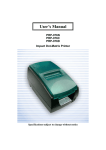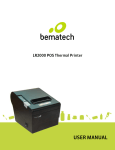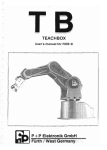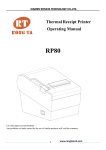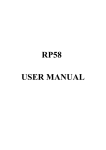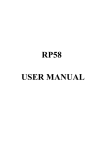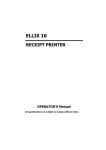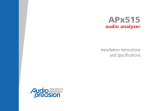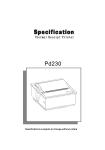Download Epson PRP-080 User`s manual
Transcript
User's Manual
PRP-080 Series
THERMAL RECEIPT PRINTER
Specifications subjects to
change without notice
Contents
1. General Information
1.1) Main Features...................................................................... 2
1.2) PRP-080I (Standard) & PRP-080II
(Advanced) Function Comparison...................................... 3
2. Quick Start
2.1) Unpacking & Parts Identification....................................... 4
2.2) Loading the Paper Roll....................................................... 5
3. Printer Interface and Connection
3.1) Connecting the Interface Cable........................................... 8
3.2) Connecting to a Cash Drawer............................................. 8
3.3) Connecting the AC Adapter................................................ 9
4. Configuration
4.1) Panel LED indicators...........................................................10
4.2) DIP Switch Settings............................................................. 12
4.3) Printer Self Test................................................................... 12
4.4) Driver Installation................................................................12
5. Safety and Maintenance
5.1) Safety Information............................................................... 14
5.2) Periodical Cleaning..............................................................14
5.3) Preventing Paper Jams.........................................................14
5.4) Fixing Paper Jam................................................................. 15
6. Appendix
- Product Specifications................................................................ 16
- Configuration.............................................................................. 19
7. General Printer Commands...................................................... 24
-1-
1. General Information
Models
PRP-080
-
1.2) PRP-080I (Standard) & PRP-080II (Advanced)
Function Comparison
Interface P = Parallel
S = Serial
Color
M = Beige
B = Black
Font
I = International font
B = Big 5 Chinese font
G = GB Chinese font
K = Korean font
J = Japanese font
(without cutter model is optional)
Version I = Standard
II = Advanced*
Note: International font can be combined with others, for example
PRP-080I-BI-MS, standard, Big5+International, beige, serial
1.1) Main Features
1. High speed printing:
· 160 (for PRP-080II)~220 (for PRP-080I) mm/s maximum print speed.
· Low-noise thermal printing.
· High reliability due to a stable mechanism.
2. Application Software:
· Command protocol is based on the ESC/POS standard.
· Various Layouts are possible by using page mode (#).
· Characters can be scaled up to 64 times as large as the standard size.
· Smoothing is also possible.
· Repeated operation and copy printing are possible by using macro
definitions.
· Character font size (12 24 font or 24 24 font) can be selected using a
command.
3. Printer Handling:
· Easy paper-roll installation.
· Equipped with an auto cutter.
· The printer allows easy maintenance for tasks such as head cleaning.
· Two different print densities can be selected by DIP switches.
· The built-in interface provides control capability for one cash drawer.
-2-
1. PRP-080I (Standard)
1.
2.
3.
4.
5.
6.
7.
8.
9.
10.
11.
12.
13.
14.
Maximum printing speed 220mm/sec
EPSON ESC/POS commands compatible
(see PRP-080 command sets for programming reference)
Characters can be scaled up to 4 times larger than standard size (double width,
double height)
Transmit status not supported
Print data in page mode not supported
Support Font A (12*24) characters
NV Image Download not supported
Two indicator LEDs (Power and Status)
Two Panel Buttons (Feed and Online)
Two indicator LEDs (Power and Status)
Two Panel Buttons (Feed and Online)
Warning beep sounds not supported
Dip switch to select Chinese / ASCII mode not supported
Support printer server printing
Support 4800, 9600, 19200, 38400bps baud rate
o
Print with 90 rotation not supported
2. PRP-080II (Advanced)
1.
2.
3.
4.
5.
6.
7.
8.
9.
10.
11.
12.
13.
14.
Maximum printing speed 160mm/sec (576 dots or 150mm/sec 512 dots
Fully-compatible with EPSON ESC/POS commands (see PRP-080 command
sets for programming reference
Characters can be scaled up to 8 times larger than standard size (*
Support transmit status
Support print data in page mode
Support Font A (12*24) and Font B (9*17) characters (*
Support NV Image Download
Three indicator LEDs POWER, ERROR, and Paper roll out and One Panel
button FEED
Three indicator LEDs POWER, ERROR, and Paper roll out and One Panel
button FEED
Support warning beep sound
Support dip switch to select Chinese / ASCII mode
Support printer server printing
Support 4800, 9600, 19200, 38400bps baud rate
o
Support print with 90 rotation *
Note (*) items are the functions that will affect printing speed
-3-
1. General Information
Models
PRP-080
-
1.2) PRP-080I (Standard) & PRP-080II (Advanced)
Function Comparison
Interface P = Parallel
S = Serial
Color
M = Beige
B = Black
Font
I = International font
B = Big 5 Chinese font
G = GB Chinese font
K = Korean font
J = Japanese font
(without cutter model is optional)
Version I = Standard
II = Advanced*
Note: International font can be combined with others, for example
PRP-080I-BI-MS, standard, Big5+International, beige, serial
1.1) Main Features
1. High speed printing:
· 160 (for PRP-080II)~220 (for PRP-080I) mm/s maximum print speed.
· Low-noise thermal printing.
· High reliability due to a stable mechanism.
2. Application Software:
· Command protocol is based on the ESC/POS standard.
· Various Layouts are possible by using page mode (#).
· Characters can be scaled up to 64 times as large as the standard size.
· Smoothing is also possible.
· Repeated operation and copy printing are possible by using macro
definitions.
· Character font size (12 24 font or 24 24 font) can be selected using a
command.
3. Printer Handling:
· Easy paper-roll installation.
· Equipped with an auto cutter.
· The printer allows easy maintenance for tasks such as head cleaning.
· Two different print densities can be selected by DIP switches.
· The built-in interface provides control capability for one cash drawer.
-2-
1. PRP-080I (Standard)
1.
2.
3.
4.
5.
6.
7.
8.
9.
10.
11.
12.
13.
14.
Maximum printing speed 220mm/sec
EPSON ESC/POS commands compatible
(see PRP-080 command sets for programming reference)
Characters can be scaled up to 4 times larger than standard size (double width,
double height)
Transmit status not supported
Print data in page mode not supported
Support Font A (12*24) characters
NV Image Download not supported
Two indicator LEDs (Power and Status)
Two Panel Buttons (Feed and Online)
Two indicator LEDs (Power and Status)
Two Panel Buttons (Feed and Online)
Warning beep sounds not supported
Dip switch to select Chinese / ASCII mode not supported
Support printer server printing
Support 4800, 9600, 19200, 38400bps baud rate
o
Print with 90 rotation not supported
2. PRP-080II (Advanced)
1.
2.
3.
4.
5.
6.
7.
8.
9.
10.
11.
12.
13.
14.
Maximum printing speed 160mm/sec (576 dots or 150mm/sec 512 dots
Fully-compatible with EPSON ESC/POS commands (see PRP-080 command
sets for programming reference
Characters can be scaled up to 8 times larger than standard size (*
Support transmit status
Support print data in page mode
Support Font A (12*24) and Font B (9*17) characters (*
Support NV Image Download
Three indicator LEDs POWER, ERROR, and Paper roll out and One Panel
button FEED
Three indicator LEDs POWER, ERROR, and Paper roll out and One Panel
button FEED
Support warning beep sound
Support dip switch to select Chinese / ASCII mode
Support printer server printing
Support 4800, 9600, 19200, 38400bps baud rate
o
Support print with 90 rotation *
Note (*) items are the functions that will affect printing speed
-3-
2. Quick Start
2.1) Unpacking & Parts Identification
2.2) Loading the Paper Roll
a. Make sure that the paper roll matches the printer's specification. Do not use
paper rolls that have the paper glued to the core because the printer cannot
detect the paper end correctly.
a. Unpacking:
Important: The printing quality and lifespan of the thermal head cannot be
guaranteed if any paper other than that recommended is used. Thus,
the warranty will be void automatically if any fault occurs due to
the use of wrong paper rolls.
Recommended Paper Rolls
Part Number
HPK-110
AF50KS-E
TF-50KS-E
PD-160R
F380
B. Parts Identification:
Printer cover
Open this cover to load
or replace paper.
Control panel
Features LED indicators
to indicate printer
status and buttons to
operate the printer.
Manufacturer
Hansol Patech Co. Ltd.
JUJO Paper Co. Ltd.
Nippon Paper Industries Co. Ltd.
New Oji Paper Mfg. Co. Ltd.
Nansaki Specialty Papers Inc.
b. Open the paper roll cover by pressing the cover-open button
Front cover
Cover Open lever
Pull this lever in the
direction of the
arrow to open the
printer cover.
Cover-Open lever
Important: Do not pull the cover open lever and open the printer cover when
printing is in progress.
-4-
-5-
c. While observing the direction of the roll, set the paper roll into the hollow, and
pull on the leading edge of the paper toward you as shown:
e. Tear off the paper outside the cover as shown.
d. Close the cover: When closing the cover, press the center of printer cover
firmly to prevent paper miss-loading
-6-
-7-
3. Printer Interface and Connection
3.1) Connecting the Interface Cable
3.3) Connecting the AC Adapter
a. Before connecting/disconnecting the interface cable, make sure that power
to the printer and all the devices connected to the printer is turned off.
a. Connect the AC power cord to the inlet of AC adapter, and then connect the
power cord plug to a suitable electrical outlet.
b. Connect the interface cable to the connector on the rear panel of the printer.
c. In the case of a serial interface, tighten the connector screws. In the case of a
parallel interface, fasten the connector clasps.
Plug the cable connector securely
into the printer's interface connector.
b. Connect the adapter cable to power connector of printer; make sure the
printer power switch is OFF before making any connections.
Attach the other end of the
cable to the computer
CAUTION:
DO NOT USE ANY AC POWER ADAPTERS OTHER THAN SPECIFIED.
3.2) Connecting to a Cash Drawer
c. Set the power switch as shown. The POWER lamp on the control panel will
light up.
Important:
· Make sure that the printer is turned off and unplugged from the AC outlet
and that the computer is turned off before making connections.
· Do not connect a telephone line into the peripheral drive connector. Failure
to observe this may result in damage to the printer.
-8-
-9-
4. Configuration
Printer Control Panel & Status Indication
4.2) DIP Switch Settings
The DIP switch panel is locating at bottom of the printer as shown:
4.1) Panel LED indicators
a. PRP-080I (Standard)
a. PRP-080I (Standard)
DIP Switch Functions:
Switch Function
ON
OFF Default
1
Baud Rate (*)
38400 19200 OFF
2
Auto Cutter
No
Yes
OFF
3
Color Deepness Deeper Normal OFF
4
Beep
Yes
No
OFF
(Blue LED) The POWER light is on whenever
the printer is on.
(Red LED) This indicates printer online/offline
status or an error
(Button) Press the FEED button to feed roll paper.
b. PRP-080II (Advanced)
(Button) Press the ONLINE button to set printer
ONLINE/OFFLINE
Printer Status (Red LED)
· Red light ON: Indicates that the printer is online.
· Red light OFF: Indicates that the printer is offline.
· Red light flashes: Indicates the printer error(s) such as out of paper, paper
jammed, or printer cover is not closed properly
b. PRP-080II (Advanced)
1. Power (POWER) LED: Green
On:Power is stable
Off:Power is not stable
2. Error (ERROR) LED: Red
On: Off line (except during paper feeding using the FEED button and
test printing, and the error state.)
Off: Normal condition
3. Paper roll end (PAPER OUT) LED: Red
On: The paper roll near end is detected.
Off: Paper is loaded (Normal condition).
DIP Switch Functions:
Switch
Function
SW-1
Select cutter
SW-2
Select beeper
SW-3
Print density
SW-4
Two-byte character code
SW-5
Reserve
SW-6
Reserve
SW-7
Select Baud rate
SW-8
Select Baud rate
SW-7
ON
OFF
ON
OFF
SW-8
ON
ON
OFF
OFF
ON
No
Yes
Dark
No
OFF
Yes
No
Light
Yes
Default
OFF
OFF
OFF
OFF
OFF
OFF
OFF
OFF
Baudrate(bps)
38400
4800
9600
19200
Note: Before configure the DIP switch settings, please first turn the printer
power off and remove the paper roll.
(*) Baud Rate is only available for serial interface models.
-10-
-11-
4.3) Printer Self Test
3. Please choose the OS that matches with your computer system and press
Next.
This is to test whether the printer is working properly or not and also checks the
printing quality, firmware version, and DIP switch settings
1. Hold the ONLINE (*) button first and then turn on the power at the same
time, release the button after around 1 second.
2. If the printer is working properly, it should then automatically print the selftesting result that indicating the firmware version number, printer connection
type, English alphanumeric characters, and few Taiwan fonts.
3. The test print will be ended with the following message:
*** COMPLETED ***
Note: (*) For PRP-080II, please press FEED button. The above procedure does
not test parallel or serial ports. Please use communication utility such as
Windows HyperTerminal to test the printer connection.
4. Please select PRP-080 Series for Install Module. For Printer Port Setting, if
you are connecting the printer to PC COM ports via RS-232 connection, the
FlowControl must be set to Hardware. Press Finish when you done all the
setting to end installation.
4.4) Driver Installation
1. To install the PRP-080 (*) driver, please insert the bundled CD disk into the
CD-ROM drive.
2. In the CD-Rom menu, please go to Receipt Printer > PRP-080 and double
click the setupEN 4.0.exe file to begin the driver installation process and
follow the installation instructions.
-12-
-13-
5. Safety and Maintenance
5.1) Safety Information
5.4) Fixing Paper Jam
1.
2.
3.
4.
5.
Do not touch the HEAD of printer with anything.
Do not touch the cutter blade.
Only use the power supply that is come along with the printer.
Do not bend the power cord excessively or place any heavy objects onto it.
When connecting or disconnecting the plug, always hold the plug- not the
cord.
6. Keep the desiccant out of children's reach.
7. Use only approved accessories and do not try to disassemble, repair or
remodel it for yourself.
8. Do not let water or other foreign objects in the printer.
9. Install the printer on the stable surface. -Choose a firm, level surface where
the printer will not be exposed to vibration.
10. Do not use the printer when it is out of order. This can cause a fire or an
electrocution.
11. Do not connect a telephone line into the peripheral drive connector.
12. We recommend that you unplug the printer from the power outlet whenever
you do not plan to use it for long periods.
5.2) Periodical Cleaning
Printed characters may become partially unclear due to accumulated paper dust
and dirt. To prevent such a problem, paper dust collected in the paper holder
and paper transport section and on the surface of the thermal head must be
removed periodically. Such cleaning is recommended to be carried out once six
month or one million lines.
a. Cleaning the Thermal Head
To remove blackish dust collected on the surface of the thermal head, wipe it
with Isopropyl alcohol (IPA).
Note: The thermal head is easy to damage, so clean it gently with a soft cloth.
Take sufficient care not to scratch it when cleaning it.
The Status LED (Red) on the printer control panel will flash with beeps if paper
is jammed. Please follow the below instruction to remove paper jam.
a. Switch the printer power off.
b. Open the printer cover by pushing the
Cover-Open button.
c. If the printer cover opens, removed the
jammed paper gently (take care not to
touch the printer head.) And reinstall
the paper roll.
d. If the printer cover will not open, please restart the printer by switching
power off/on, and try again, if the cover is still unable to open please follow
the instructions below:
1. Set the printer power OFF
2. Slide off the front cover to reveal
the auto cutter
3. Roll the little gear as shown until
the warning beeps is stopped.
CAUTION:
Since working on the cutter may be dangerous, be sure to turn off the printer
first.
Note:
Do not apply extreme force to open the front cover to prevent damages to the
cutter. If the front cover will not open properly, please contact your dealer.
e. Return the cutter to its home-position and release or clean out the jammed
paper in inside the front cover. Open the top cover, and then reinstall paper
roll.
b. Cleaning the Paper Holder
Use a soft cloth to remove paper dust from the paper holder and paper
transport section.
5.3) Preventing Paper Jams
The paper should not be touched during printing. Shift the paper during paper
ejection may cause a feed failure or paper jam.
-14-
(Reinstall Paper Poll)
(Tear off the paper as shown)
-15-
6. Appendix
1. Product Specifications
1.1) Printing Specifications
1.
2.
3.
4.
5.
6.
7.
8.
Printing method:
Dot density:
Printing direction:
Printing width:
Characters per line (default):
Character spacing (default):
Printing speed:
High speed mode:
Thermal line printing
203 dpi 203 dpi.
Unidirectional with friction feed
72 mm (2.83"), 576 dot positions
Font A: 48, English Font B: 24, Chinese
Font A: 0.25 mm (.01") (2 dots)
160 mm/second, maximum (at 24V, 20C
(68F), Density level 2. Speeds are switched
automatically depending on the voltage
applied to the printer and head
temperature conditions.)
NOTE: There may be variations in printing after switching the mode of the
printing speed. To prevent this for logo printing with ESC command,
using a downloaded bit image is recommended. Change in printing
speed does not occur during down loaded bit image printing. Printing
speed may be slower depending on the data transmission speed and
the combination of control commands. Low transmission speed may
cause intermittent printing. It is recommended to transmit data to the
printer as quickly as possible.
1.4) Paper Specification
1. Paper type:
2. Form:
3. Paper width:
4. Paper roll size:
5. Specified paper:
6. Paper roll spool diameter:
Specified thermal paper
Paper roll
79.5 0.5 mm (3.13" 0.02")
Roll diameter: Maximum 83 mm
Specified thermal roll paper;
NTP080-80
Original paper: PD 160R
(Oji Paper Mfg. Co. Ltd.)
Original paper: AF50KS-E
(Jujo Thermal Oy (Finland))
Original paper: P350 (F380), P310, P300
Inside: 12 mm (.47")
Outside: 18 mm (.71")
NOTE: Paper must not be pasted to the paper roll spool.
1.5) Internal Buffer
1. Receive buffer useable 20K bytes.
2. User-defined buffer (both for user-defined characters and user-defined bit
images): 12K bytes
1.6) Electrical Characteristics
1.2) Auto Cutter
1. Partial cut:
Cutting with one point left uncut
NOTE: To prevent dot displacement, after cutting, paper must be fed
approximately 1 mm (14/360 inches) or more before printing.
1. Supply voltage:
+24 VDC 8% (optional power supply)
2. Current consumption (at 24V): High speed mode:
Mean: Approximately 1.8A(Character font
A -N, capital letters, 36-character rolling
pattern, 42 columns printing)
Peak: Approximately 8A
Low power consumption mode:
Mean: Approximately 1.2A
Peak: Approximately 6.6 A Standby:
Mean: Approximately 0.2A
1.3) Paper Roll Supply Device
1. Supply method:
Drop-in paper roll
-16-
NOTE: Maximum 1A for drawer kick-out driving.
-17-
1.7) Reliability
1. Life Span:
2. MTBF:
3. MCBF:
2. CONFIGURATION
Mechanism: 15,000,000 lines
Thermal head: 100 million pulses, 100 Km
Auto cutter: 1,500,000 cuts
(End of life span is defined to have reached
the end of its life when it reaches the
beginning of the Wear out Period.)
360,000 hours
(Failure is defined as Random Failure
occurring at the time of the Random Failure
Period.)
52,000,000 lines
(This is an average failure interval based on
failures relating to wear out and random
failures up to the life of 15 million lines.)
1.8) Environmental Conditions
Operating: 5 to 45C (41 to 113F)
Storage: -10 to 50C (14 to 122F)
(except paper)
2. Humidity:
Operating: 10 to 90% RH
Storage: 10 to 90% RH (except for paper)
NOTE: If the printer is not used for a long time with paper installed, some part
of the printing may be light due to the deformation of the paper. If the
printer is not used for a long time with paper installed, be sure to feed
paper approximately 30 mm before printing
2.1) Interface
a. RS-232 serial interface
a.1) RS-232 Specifications
1. Data transmission:
2. Synchronization:
3. Handshaking:
4. Signal levels:
5. Baud rate:
6. Data word length:
7. Parity Settings:
8. Stop bits:
9. Connector (printer side):
Serial
Asynchronous
DTR/DSR or XON/XOFF control
MARK = -3 to -15 V: Logic "1"/ OFF
SPACE = +3 to +15 V: Logic "0"/ ON
4800, 9600, 19200, 38400 bps
8 bits
None
1 or more
Female DSUB-25 pin connector
1. Temperature:
NOTE: The data word length, baud rate, and parity depend on the DIP switch
settings.
The stop bit for the printer side is fixed to 1.
a.2) Serial interface connection example
Printer Side DB-25
3. Acoustic noise (Operating):
POS RS-232 Connection DB9
When using auto cutter Approximately 50
dB (Bystander position) When not using
auto cutter: Approximately 40 dB
(Bystander position)
1.9) Installation
The PRP-080P series printer must be installed horizontally. (Vibration during
paper cutting and using a drawer should be considered. Take measures to
prevent the printer from moving. Affixing tapes are provided as an option.) An
optional hanging bracket can attach the printer to a wall. (Following the
procedures describes in the installation manual, install the wall mount and
change the location of the paper roll near-end sensor, then install the paper roll
stopper and other parts.)
-18-
NOTE: Set the handshaking so that the transmit data can be received.
Transmit data to the printer after turning on the power and initializing
the printer.
-19-
1.nterface connector terminal assignments and signal functions
Pin number Signal name Signal Source Description
2
TXD
Printer
When using XON/XOFF
handshake protocol, printer
transmits control code XON/XOFF
3
RXD
Host
Printer receives data from host
4
RTS
Printer
Indicates printer current status,
whether the printer is Busy or
Ready to receive data
7
GND
Signal ground
20
DTR
Printer
Same as RTS (pin 4)
b. IEEE 1284 Bidirectional Parallel Interface(Parallel Interface
Specifications)
b.1) Parallel Specifications
1. Data transmission:
2. Synchronization:
3. Handshaking:
4. Signal levels:
5. Data word length:
6. Connector (printer side):
Parallel
Externally supplied nStrobe signals
nAck and Busy signals
TTL compatible
8 bits
36 pins Centronics connector
b.2) Parallel Interface Pin Assignments for Each Mode
Pin
1
Mode
/STB
Source
Host
2
DATA0
Host
3
4
5
6
7
8
9
10
DATA1
DATA2
DATA3
DATA4
DATA5
DATA6
DATA7
nAck
Host
Host
Host
Host
Host
Host
Host
Printer
11
BUSY
Printer
12
13
14 15
16 17
18
19 30
31
32
GND
Select
NC
GND
Logic-H
GND
NC
Nerror
(nFault)
GND
NC
33
34 36
-20-
The computer presents the data on the
data lines, and pulses STB
Indicates the 1st data bit through 8th
data bit
Printer acknowledge signal which
indicates that printer has received
previous data bit
Printer is busy and cannot receive
data
Ground
High electric potential
No Connect
Ground
High electric potential
Ground
No Connect
Printer Error Signal
Printer
Printer
Printer
Ground
No Connect
-21-
2.2) Connectors
a. Interface Connectors
Refer to Interface explain.
3. Drawer kick-out drive signal
b. Power Supply Connector
This connector is used to connect the printer to an external power source.
Power Supply Connector Pin Assignments
Pin Number
1
2
3
Shell
Output signal:
Output voltage: Approximately 24 V
Output current: 1A or less
Signal Name
+24 VDC
GND
NC
Frame GND
c. Drawer Kick-out Connector (Modular Connector)
The pulse specified by ESC p or DLE DC4 is output to this connector. The
host can confirm the status of the input signal by using the DLE EOT, GS a,
or GS r commands.
1. Pin assignments: Refer to Table
2. Connector model: Printer side:
User side:
MOLEX 52065-6615 or
RJ11 telephone jack
6-position 6-contact
(RJ11 telephone jack)
Drawer Kick-out Connector Pin Assignments
Pin Number
1
2
3
4
5
6
Signal Name
NC
Frame GND
NC
Drawer kick-out drive signal
NC
NC
-22-
Direction
Output
Output
-23-
General Printer Commands
Command Lists:
Command
Code Description
Function Description
(Hex)
09
Horizontal tab
LF
0A
Print and line feed
CR
0D
ESC SP n
1B 20 n 0
n
255
ESC ! n
1B 21 n 0
n
255
ESC $ nL nH
1B 24 nL nH
0 nL 255
0 nH 255
Set absolute print position
ESC % n
1B 25 n
0 n 255
Select/cancel user-defined
character set
ESC & y c1 c2
1B 26 y c1 c2
y=3 32 c1 c2 126
Define user-defined characters
ESC
n
Print and carriage return
1B 2D n
0 n 2 48
1B 32
ESC 3 n
1B 33 n 0
ESC ? n
1B 3F n 32
ESC @
ESC D n1
nk NUL
ESC G n
Set right-side character spacing
Select print mode(s)
dk 1B 2A m nL nH d1 dk
Select bit-image mode
m=0,1,32,33 0 nL 255
0 nH 3 0 d 255
ESC 2
Turn underline mode on/off
n
50
Select default line spacing
n
255
n
126
Set line spacing
Initialize printer
1B 44 n1 nk 00
1 n 255 0 k
Set horizontal tab positions
32
1B 47 n 0
n
255
n
255
Turn on/off double-strike mode
ESC J n
1B 4A n 0
ESC \ nL nH
1B 5C nL nH
0 nL 255
0 nH 255
Set relative print position
ESC c 5 n
1B 63 35 n
0 n 255
Enable/disable panel buttons
1B 64 n
ESC p m t1 t2
1B 70 m t1 t2
m=0,1,48,49
0 t1 255 0
0
n
255
Print and feed paper
Print and feed n lines
Generate pulse
t2 255
-24-
GS * x y d1
Function Description
d(x y 8) 1D 2A x y d1(x y 8)
1 x 255 1 y 48
x y 1536 0 d 255
Define downloaded bit image
GS / m
1D 2F m
0 m 3 48 m 51
Print downloaded bit image
GS L nL nH
1D 4C nL nH
0 nL 255
0 nH 255
Set left margin
GS W nL nH
1D 57 nL nH
0 nL 255
0 nH 255
Set printing area width
ESC E n
1B 45 n 0
n
255
Turn emphasized mode on/off
ESC R n
1B 52 n 0
n
13
Select an international
character set
ESC a n
1B 61 n
0 n 2 48
Select justification
n 50
ESC t n
1B 74 n 0
n
7 n=19
Select character code table
ESC { n
1B 7B n 0
n
255
Turns on/off upside-down
printing mode
GS H n
1D 48 n
0 n 3 48
Cancel user-defined characters
1B 40
ESC d n
Code Description
(Hex)
HT
ESC * m nL nH d1
Command
n
51
(1) GS V m
(2) GS V m n
1D 56 m m=0,1,49
1D 56 m n m=66
0 n 255
GS h n
1D 68 n 1
n
255
(1) GS k m d1
dk NUL 1D 6B m d1 dk 00
0 m 6
(2) GS k m n d1 dn
1D 6B m n d1 dn
65 m 73
Select printing position
for HRI characters
Select cut mode and cut paper
Select bar code height
Print bar code
GS v 0 m xL xH yL yH 1D 76 30 m xL xH yL
Print raster bit image
d1 dk
yH d1 dk
0 m 3 48 m 51
0 xL 255 0 xH 255
0 yL 255 0 d 255
k=(xL+xH 256) (yL+yH
256)
GS w n
1D 77 n 2
n
6
-25-
Set bar code width
PRP-080I & II COMMANDS COMPARISON
Command
Name
HT
LF
FF
Horizontal tab
Print and line feed
Print and return to standard
mode in page mode
Print and carriage return
Cancel print data in page mode
Real-time status transmission
Real-time request to printer
Generate pulse at real-time
Print data in page mode
Set right-side character spacing
Select print mode(s)
Set absolute print position
Select/cancel user-defined character set
Define user-defined characters
[x1 d1 d(y X x1)] [xk d1 d(y X xk)]
Select bit-image mode
CR
CAN
DLE EOT n
DLE ENQ n
DLE DC4 n m t
ESC FF
ESC SP n
ESC ! N
ESC $ nL nH
ESC % n
ESC & y c1 c2
ESC & y c1 c2
ESC * m nL nH
D1 dk
ESC - n
ESC 2
ESC 3 n
ESC = n
ESC ? N
ESC @
ESC D n1
nk Annual
ESC E n
ESC G n
ESC J n
ESC L
ESC M n
ESC S
ESC T n
ESC V n
ESC W xL xH
yL yH dxL dxH
dyL dyH
ESC \ nL nH
ESC a n
ESC c 5 n
ESC d n
PRP-080I
(Standard)
*
*
PRP-080II
(Advanced)
*
*
*
*
*
*
*
*
*
*
*
*
*
*
*
*
*
*
*
*
*
Turn underline mode on/off
Select default line spacing
Set line spacing
Set peripheral device
Cancel user-defined characters
Initialize printer
Set horizontal tab positions
*
*
*
*
*
*
*
*
*
*
*
*
*
*
Turn emphasized mode on/off
Turn double-strike mode on/off
Print and feed paper
Select page mode
Select character font
Select standard mode
Select print direction in page mode
o
Turn 90 clockwise rotation mode on/off
Set printing area in page mode ESC
W xL xH yL yH dxL dxH dyL dyH
*
*
*
*
*
*
*
*
*
*
*
*
*
Set relative print position
Select justification
Enable/disable panel buttons
Print and feed n lines
*
*
*
*
Command
Name
ESC p m t1 t2
ESC { n
FS p n m
GS ! N
GS # n
GS $ nL nH
General pulse
Turns on/off upside-down printing mode
Print NV bit image
Select character size
Define NV bit image number
Set absolute vertical print position
in page mode
Define downloaded bit image
GS* x y d1 d(x X y X 8)
Print downloaded bit image
Start/end macro definition
Turn white/black reverse printing mode
Select printing position for HRI characters
Set left margin
Set horizontal and vertical motion units
Select cut mode and cut paper
GS* x y d1
d(x X y X 8)
GS / m
GS :
GS B n
GS H n
GS L nL nH
GS P x y
GS V m /
GS V m n
GS W nL nH
GS \ nL nH
GS ^ r t m
GS f n
GS h n
GS r n
GS v 0 m xL xH
yL yH d1 dk
GS w n
FS ! n
FS &
FS
n
FS .
FS 2 c1 c2
D1 dk
FS S n1 n2
FS W n
-26-
*
*
*
*
Set printing area width
Set relative vertical print position
in page mode
Execute macro
Select font for HRI characters
Select barcode height
Transmit status
Print raster bit image
GS v 0 m xL xH yL yH d1 dk
Set barcode width
Set print mode(s) for Kanji characters
Select Kanji character mode
Turn underline mode on/off for
Kanji characters
Cancel Kanji character mode
Define user-defined Kanji characters
FS 2 c1 c2 d1 dk
Set left- and right-side Kanji
character spacing
Turn quadruple-size mode on/off for
Kanji characters
PRP-080I
(Standard)
*
*
PRP-080II
(Advanced)
*
*
*
*
*
*
*
*
*
*
*
*
*
*
*
*
*
*
*
*
*
*
*
*
*
*
*
*
*
*
*
*
*
*
*
*
*
*
*
Command classification
Executing: Printer executes the command, which does not then affect the following data.
Setting: Printer uses flags to make settings, and those settings affect the following data.
-27-
Command classification
Executing: Printer executes the command, which does not then affect
the following data.
Setting:
Printer use flags to make setting and those setting affect the
Range
Description
Note:
Commands for International Fonts
ESC R n
ASC
Range
Description
n
0
Select an International Character Set Format
ESC
R
n
Hex
1B
52
n
Decimal
27
82
n
0 < n < 13
Selects an international character set n from the
following table:
N
0
1
2
3
4
5
6
7
8
9
10
11
12
13
Default
ESC t n
Format
Default
n=0
-28-
Page
Pc437:
[USA, Standard Europe]
Katakana [Japanese]
PC850 [Multilingual]
PC860 [Portuguese]
PC863 [Canadian-French]
PC865 [Nordic]
West Europe
Greek
Hebrew
PC755 [Latvian/East Europe]
Iran
WPC1252
PC866 [Cyrillic#2]
PC852 [Latin2]
PC858
Big 5 Chinese
GB Chinese
Korean
Japanese Kanji (JIS)
1
2
3
4
5
6
7
8
9
10
16
17
18
19
Character set
U.S.A.
Franch
Germany
U.K.
Denmark
Sweden
Italy
Spain
Japan
Norway
Denmark
Spain
Latin America
Korea
Select character code table
ASC
ESC
t
n
Hex
1B
74
n
Decimal
27
116
n
0 <= n < =10, 16<= n < =19,
Selects a page n from the character code table:
n=0
-29-
Comment
Optional
Optional
Optional
Optional
Character code can also be selected by utility program.
1. To install the PRP-080 Default Code Page Setting utility, please insert the
bundled CD disk into the CD-ROM drive.
2. In the CD-Rom menu, please go to Receipt Printer > PRP-080 > Code Page
and double click the setup.exe file to begin the installation process and
follow the installation instructions.
3. After installation is done, go to Program Files > CodePageSet >
CodePageSet to start the utility.
4. For Serial interface connection, please select the proper COM port and baud
rate which matches the current setting of the printer. For Parallel interface
connection, select the proper LPT ports.
-30-
-31-
Optional multilingual character model supports printing with one of the
following characters:
a. B - Traditional Chinese (Big 5)
b. G - Simplify Chinese (GB)
c. K - Korean
d. J- Japanese Kanji (JIS)
To enable/disable the multilingual character code use the following
commands: (*)
FS
&
[Format]
Select Multilingual Character Mode ON
ASCII
FS
&
Hex
1C
26
Decimal
28
38
[Description] Enable multilingual character mode
----------------------------------------------------------------------FS
.
[Format]
Select Multilingual Character Mode OFF
ASCII
FS
.
Hex
1C
2E
Decimal
28
46
[Description] Disable multilingual character mode
(*)Note: This command enable/disable the specific language according to
the model (B, G, K or J)
-32-



















